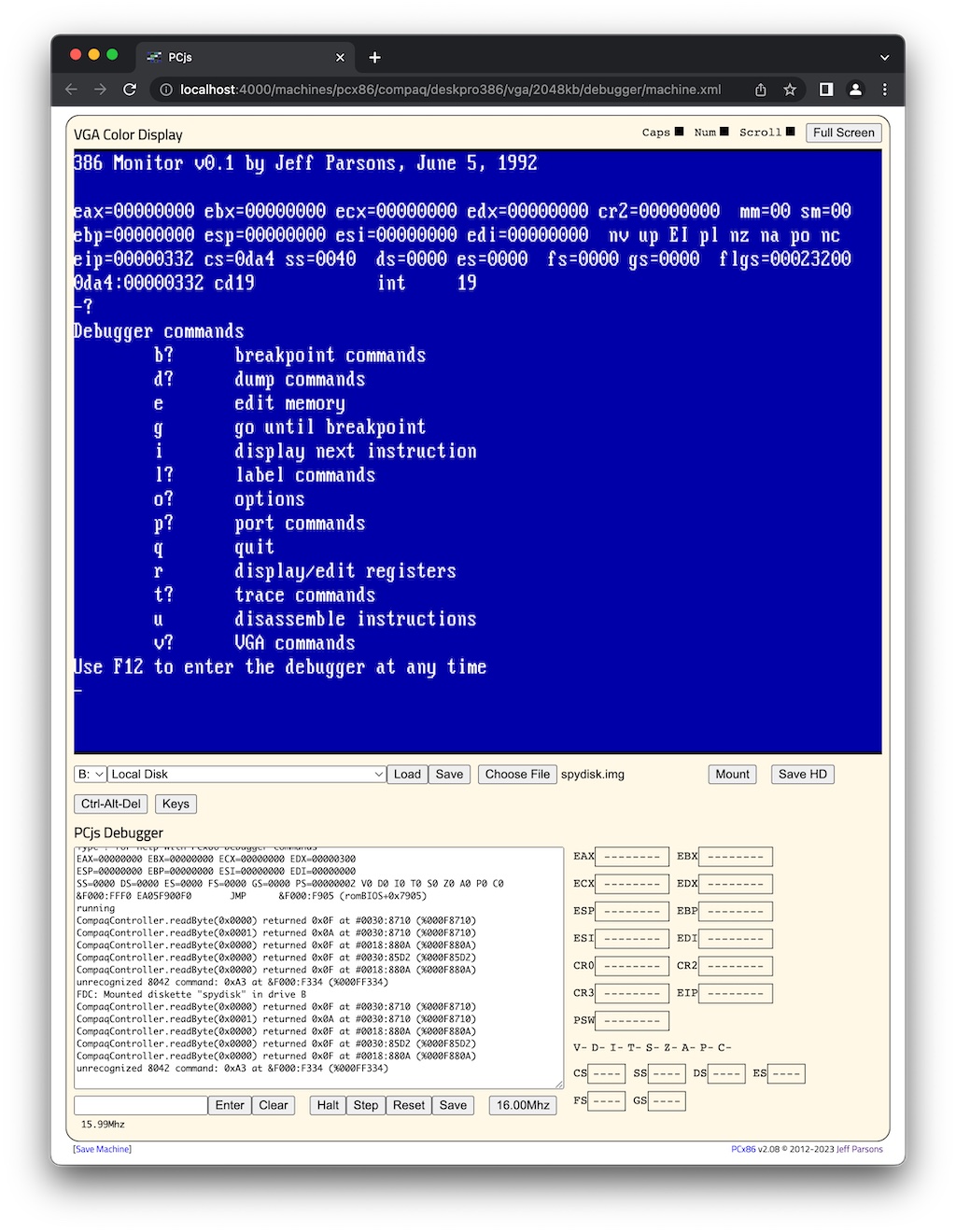This is a resurrected version of a tool I wrote some 30 years ago to help debug issues with DOS (or other real-mode x86 software), especially issues occurring during the boot process, or issues that couldn't easily be debugged with a conventional debugger. It effectively reboots the machine in v86-mode, with the debugger running in protected-mode, waiting for a hotkey (F12) or any unexpected faults, and interacts with the user via VGA and PC keyboard or serial port.
Since this tool was never meant to be an actual product, it makes lots of assumptions, does the bare minimum required to get the job done, probably contains a number of mistakes and bugs, and will no doubt crash in a variety of circumstances.
But, that said, I still think it's a cool and potentially still useful piece of software.
Operation is simple: on an 80386 machine, from a real-mode DOS prompt, run SPY. Think of SPY like a glorified TSR, except that instead of terminating-and-staying resident somewhere within the first 640K, SPY switches to protected mode, relocates itself above 1Mb, saves the contents of the screen, switches to its built-in debugger, and then waits for you to give it a command.
The SPY debugger's '?' command will give you a list of other commands. At this point, you would normally just type 'g', which returns execution back to the real-mode portion of SPY -- except that now the machine is running in v86-mode instead of real-mode.
You can press the F12 key at any time to jump back into the SPY debugger, inspect memory, set breakpoints, etc. You can even inspect the original screen using the 'v' command; pressing any other key returns control to the debugger. I have no recollection of how "complete" the debugger is, and I'm sure I will find more bugs to fix as I begin using it -- all I've done so far is get it loaded and launched into v86-mode successfully.
SPY assumes your machine has at least 2Mb of RAM. Well, actually, it doesn't really care how much memory you have below the 1Mb line (which could be 640K or less), but it does assume you have at least 320K or so above the 1Mb line; most of that memory is used saving/restoring the entire VGA state whenever entering/exiting the SPY debugger.
When I originally archived this project, I also saved a set of tools that can be used to build SPY from scratch -- which was fortunate, because I'm not sure how easy it would be find some of those tools today.
SPY is a bit unusual because it's a COM file with a mixture of 16-bit and 32-bit code, and the 32-bit code is a mixture of assembly and C. And except for the initialization code, it does not use any operating system or ROM functions. All screen, keyboard, and serial port hardware operations are handled internally.
The C compiler, CL3232, was an early internal version of Microsoft's 32-bit C compiler that wasn't really designed for producing code in this environment -- a small flat memory model where CS != DS.
On re-examination, the compiler didn't appear to make any assumptions about CS and DS, with one exception: when generating code for switch statements, it would produce in-line jump tables, and it would "JMP" through those tables without a CS override. In other words, there was an implicit assumption that CS == DS.
So, I wrote a crude little C program, FIXASM, that looks for those "JMP DWORD PTR" instructions and inserts a "CS:" override. This also meant changing the MAKEFILE to have CL3232 produce assembly files instead object files, running the assembly files through FIXASM, and then assembling them with ML. Problem solved.
[As an added bonus, using CL3232 to produce assembly files instead of object files seems to have eliminated some overhead, because the overall size of the COM file dropped by about 5K. I haven't looked into it yet, but I did verify that all DEBUG code, including asserts, was still in place. Strange.]
There were a number of other minor problems, like some unexpected padding between code and data sections, failure to preserve the initial interrupt mask registers (IMRs), and failure to allocate memory for the VGA save/restore operations. I call these problems "minor", but they all took a while to track down. Fortunately, the PCjs Debugger was a big help. I even had to use the VSCode debugger to debug a problem with the PCjs debugger, so as an added bonus, I ended up fixing a few PCjs bugs as well.
All these issues made a few things clear: I had probably used an older version of CL3232 than what was archived here (I'll keep looking for it, but I probably don't have it anymore), and I had probably started reworking some of the SPY code in 1993 and never finished the changes.
In any case, SPY is once again operational -- or at least, really close.
In the VxD folder, I've included another variation of this tool that was designed to load as a Windows 3.x/Windows 95 VxD. I'm not sure how I found the time to work on these things while also keeping up with all my Windows 95 and MS-DOS 6 development responsibilities. Probably a lot of late nights.
